In my role at Jobvite, I see the importance of analytics in Talent Acquisition (TA) every single day. 2020 was a year of major changes across our communities and across all businesses, regardless of size, industry and sophistication. From businesses pivoting to working-from-home, to undertaking an increased focus on diversity and inclusion, to making recruiters sustainably productive outside of the traditional workplace environment. Change is the only constant, and change is accelerating. But the more data insights you have at your fingertips, the better – and faster you can make TA changes to support your business to help it thrive.
For TA professionals, getting a hold on their analytics, creating visibility, and shining a light on the most vital aspects of their performance is critically important. Budget wise, 7% of a company’s total operating budget is spent on talent acquisition, and the average cost per hire is about $4,000 (and as high as $7,000). And according to Aptitude Research, 82% of companies say data plays a critical role in driving talent acquisition decisions. Yet despite these big numbers and how vital we know the TA function is, only about 50% of companies measure TA effectiveness at all.
Not being on top of your data in today’s technology enabled world is a recipe for disaster. It gets more pronounced when you think of the perceptions (or misperceptions) of your key stakeholders, including your hiring managers.
So how do you become a data driven recruiting leader?
To start, here are 4 key takeaways based on conversations I’ve had with our customers:
- ROI or overall recruiting effectiveness – Companies that measure their processes and results are twice as likely to become successful. So, if you’re not doing a good job of measuring your TA today, turn that around, get performance clarity, and you can double your success.
- Leveraging analytics lets you become a true business partner – Data can help you become a true business partner to the company. For instance, in terms of diversity, you can start to measure against Fortune 500 companies, where we see only 5 Fortune 500 CEOs that are black and there is a disproportionate number of women in management across the board. Give your company the ability to see where it benchmarks against the rest of the world, and start driving towards improvements. Without data to see your talent diversity, it’s almost impossible to make change effectively.
- Adaptability and resilience – Being data driven allows TA teams to adapt in uncertain times. No doubt, there will be things in 2021 that will surprise us all. Use data to track, assess, and adjust your business strategies accordingly to warning signs and continue delivering.
- Building better internal relationships – Data driven transparency helps build better internal working relationships. For instance, data we see shows that 60% of hiring managers don’t get a good degree of visibility into what’s happening with their hiring on an ongoing basis. Have an expectations conversation with your hiring managers and let your data help tell the story. Discuss the hiring funnel, funnel metrics, and volume of activity. Build a better understanding, and together create expectations you can both get on board with. Also, use data to not only illustrate your team’s successes and opportunities, but inform on related issues your leadership is most concerned about.
Most leadership gets it. We talk to many companies with the best intentions, and a clear understanding of why data is important. Yet they simply don’t have the integrated solutions to drive a consistent weekly, monthly, quarterly cadence of data tracking and integration effectively. In fact, 50% of companies we talked to only measure and review their data once per year. It’s more than a missed opportunity; it’s almost shocking in today’s tech-driven world.
Why is it so difficult to get the analytics to be data driven? 1 in 3 talent acquisition professionals surveyed said that IT views talent acquisition integrations as a low priority. We know that the average company has at least 10 systems they’re using in TA. And during the pandemic, 44 percent of companies implemented new recruiting tech into that stack. However, with 10+ systems not speaking the same language or measuring in the same way, it becomes difficult (but not impossible) to get integrated data to rely on.
In recruiting, most folks believe it’s the matchmaking that’s the most important piece – and no doubt, it’s important. But data is the cohort to getting talent in a smarter, quicker, higher quality way. By tracking metrics, such as funnel, source performance, quality of talent pool, satisfaction scores, and diversity you can see how your TA strategy is performing, fine-tune what’s broken in the hiring process, and continuously improve.
The tools and opportunity are there for you – make sure you’re doing it right.




